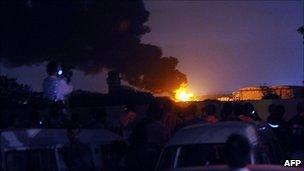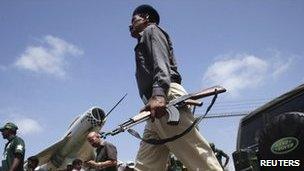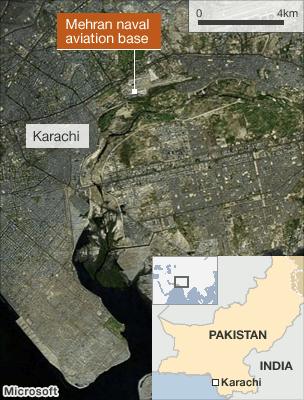'New kind of militant' behind Pakistan Karachi attack
- Published

Officials say the attack was too professional to be the handiwork of the Taliban
The deadly 15-hour siege on Pakistan's Mehran naval airbase in Karachi on Monday was carried out by attackers with military-level training, raising suspicions they had inside help.
Questions are being asked about the security of Pakistan's vital military installations after a well-organised group of gunmen held off Pakistan's equivalent of the US Navy Seals - the Special Services Group-Navy (SSG-N) - for 15 hours.
The SSG-N is said to be the most formidable fighting force in Pakistan, but - for a few hours at least - they appeared to be at the mercy of a brazen group of fighters.
"They weren't any ordinary militants - certainly not the Taliban," said one security official, who wished to remain unnamed.
"The aim of all Taliban attacks is maximum death and destruction - these men were very focused on what they were after."
Speed and organisation
From the beginning it was clear the attackers had an intricate knowledge of the base and its vulnerable areas. They were tactically assured and the operation had clearly been long in the planning.
"They came over the wall cutting the wire on the eastern side of the base," another official told the BBC, adding that it was one of the weak points. The militants knew and exploited this - just one piece of inside knowledge they had.
"That side is just next to the runway - and the guard tower is at a distance because planes land regularly."
The first time the militants were seen was when they appeared on the runway, weapons at the ready. "The [navy] men couldn't believe their eyes," says the official.
A number of officials listed to me their observations, which reinforced the conviction that they were being confronted with a new kind of militant attack:
Military formation: One injured sailor told an official that the attackers "moved and dressed like us". The militants moved in tactical military formation and spoke in military parlance. They spoke between themselves in Urdu, as well as a foreign language.
Clothing and equipment: The militants wore combat fatigues, according to officials - and had night vision goggles, carrying rocket propelled grenades [RPGs]. "It takes months of training for ease with the goggles, and years to be expert," an official told me.
Tactics and a plan: One witness said that even though the militants had clear sight of them, "they ignored us... Instead, they just aimed RPGs at the two Orions [planes] parked on the tarmac." They were clearly under instructions to destroy military hardware. They also changed tactics easily and broke away in groups, which clearly had different aims.
Crack shots: "They were excellent shots - as good as any we have," said a security official involved in the operation. They used their night vision goggles to maximum effect, witnesses say - and that was an advantage they had until the SSG-N team arrived at the scene. When the gun battle began, one security official said, it was clear that these men could "hold their own" in a firefight. The fact that they had M16 carbines and sniper rifles also set them apart.
Officials says all of this is in strong contrast to the Taliban, who adopt an equally brutal but more chaotic mode of attack. "Their best weapon is the suicide bomber - they are notoriously poor shots," one official told me.
"They were the exception to every rule of Pakistan militant tactics.
"They were also not about killing people," the official said. "It was clear they were interested in the destruction of equipment, a much more 'military' aim."
Shock and disbelief
It was only the sheer numbers of the naval personnel that prevented further damage to the aircraft in the base, one naval spokesman said.
Even so, the ferocity, speed and organisation of the onslaught still came as a shock. The planes were in flames and a gun battle was being fought within minutes.

The incident has drawn comparisons with the 2008 Mumbai (Bombay) attacks
But one of the attackers in particular caught the attention of those who were watching and bearing the brunt of the attack.
"A small young man with a light beard who later dropped his M16 for two Uzi submachine guns. He was particularly deadly - he killed one soldier with a single shot at over 600 yards."
Another clue as to the level of their training and proficiency was their ability to change tactics. One witness recounted how in the midst of the firefight the attackers appeared to change their minds and back off.
They appeared to be going for the barracks housing the Chinese engineers. Another firefight broke out until a new detachment of naval marines got to the Chinese barracks. The militants, when they realised what was happening, opened fire on the armoured vehicles the Chinese engineers were being taken away in.
Inside help
Everything about the attack pointed to a detailed knowledge of the barracks. After the Chinese engineers were taken away, they broke up into groups and one group took refuge in a nearby barracks.

"They used the building to maximum effect - they knew it and the surrounding area inside out," the official said.
"We later discovered plans to the whole compound on them."
The SSG-N finally got into the barracks and killed the remaining militants. The attackers had clearly come prepared for a long siege, bringing bags of dried fruit as rations.
Officials dismiss the explanation that the attack was in retaliation for Osama Bin Laden's death. "This took months of planning - the only parallel I can think of is Mumbai [Bombay]," one said.
Gunmen killed 165 people in the 2008 Mumbai attacks, and India has repeatedly accused Pakistan and its ISI intelligence agency of involvement in them.
"This maybe the first attack of its kind [in Pakistan]," the security official said. "But it's definitely not the last."
Officials say the only other time they have encountered such ferocity and training is in fighting al-Qaeda militants - especially Chechens and Uzbeks - in Pakistan's tribal areas.
"The way they went about their business - I could almost say they were our own commandos," says the security official.
He is not the only one who thinks that some of those involved in the attack may be serving military personnel or ex-servicemen.